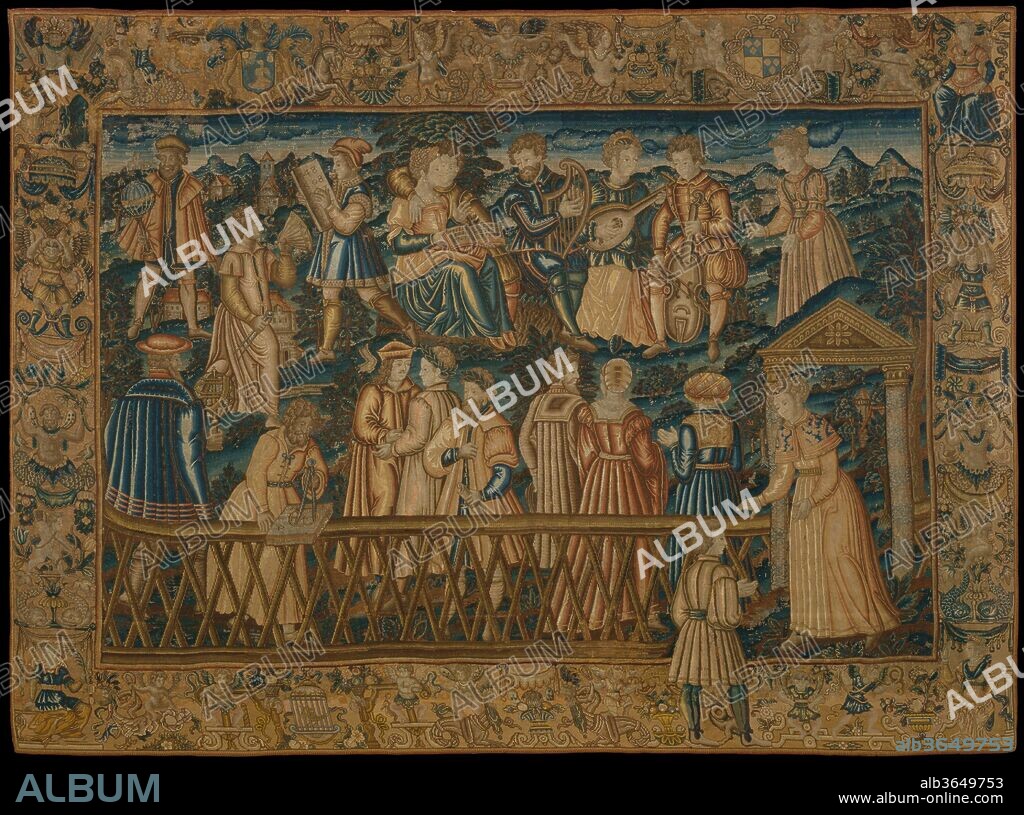alb3649753
The Garden of False Learning from The Table of Cebes

|
Añadir a otro lightbox |
|
Añadir a otro lightbox |



¿Ya tienes cuenta? Iniciar sesión
¿No tienes cuenta? Regístrate
Compra esta imagen.
Selecciona el uso:

Título:
The Garden of False Learning from The Table of Cebes
Descripción:
Traducción automática: El jardín de las falsas enseñanzas de La mesa de Cebes. Cultura: francés. Diseñador: basado en una xilografía de David Kandel (alemán, ca. 1520-ca. 1596). Dimensiones: H. 110 1/2 x W. 153 1/8 pulgadas (280,7 x 388,9 cm). Fecha: 1550-80. Este colgante bordado con aguja representa una escena de la Tabula Cebetis (La mesa de Cebes), un tratado que durante mucho tiempo se creyó erróneamente que había sido escrito por el discípulo de Sócrates, Cebes, y que gozó de gran popularidad como lector de latín en Europa en los siglos XVI y XVII. El texto describe una pintura exhibida en el Templo de Saturno en Tebas que mostraba el viaje por la vida y el camino hacia la verdadera felicidad. Este tapiz representa el penúltimo episodio del viaje: una mujer que representa el aprendizaje falso aparta al protagonista de su camino. Las figuras elegantes con vestimenta cortesana se distraen de la verdadera sabiduría y felicidad al dedicar demasiada energía a la búsqueda del conocimiento a través del debate, la filosofía, la geometría, la astrología y la alquimia, la geografía, la astronomía, la aritmética y la música. Este tapiz es uno de un conjunto de tres (los otros están en el Musée Jacquemart-André, París y el Museo Metropolitano). Su diseño fue adaptado de un grabado en madera que ilustra la Mesa de Cebes realizado por David Kandel de Estrasburgo en 1547. A pesar de la diferencia de escala (el grabado en madera mide poco más de 30 por 15 pulgadas), el diseñador del bordado tomó prestadas las figuras principales del grabado en madera. escena central, agregando ingeniosamente una cálida paleta de verdes, rojos y amarillos. El conjunto está rodeado por un borde imaginativo de grutescos retozando e incluye el escudo de armas de la familia De Fenis de Prade rodeado por el collar de la Orden de San Miguel (arriba a la izquierda) y un segundo escudo de armas no identificado encerrado por un cordeliere de viuda (arriba Correcto). Con su escala monumental, esta costura es un raro ejemplo sobreviviente de una moda de bordados que emulaba la escala y apariencia de los tapices, sus contrapartes tejidas más caras.
The Garden of False Learning from The Table of Cebes. Culture: French. Designer: Based on a woodcut by David Kandel (German, ca. 1520-ca. 1596). Dimensions: H. 110 1/2 x W. 153 1/8 inches (280.7 x 388.9 cm). Date: 1550-80.
This needlepoint hanging depicts a scene from the Tabula Cebetis (The Table of Cebes), a treatise long wrongly believed to have been written by Socrates' disciple Cebes that enjoyed great popularity as a Latin reader in Europe in the sixteenth and seventeenth centuries. The text describes a painting displayed in the Temple of Saturn in Thebes that showed the journey through life and the pathway to true happiness. This hanging depicts the penultimate episode in the journey: the protagonist is beckoned from his path by a woman representing False Learning. Elegant figures in courtly dress are distracted from true wisdom and happiness by dedicating too much energy to the pursuit of knowledge through debate, philosophy, geometry, astrology and alchemy, geography, astronomy, arithmetic, and music.
This hanging is one of a set of three (the others are in the Musée Jacquemart-André, Paris and the Metropolitan Museum). Their design was adapted from a woodcut illustrating The Table of Cebes made by David Kandel of Strasbourg in 1547. Notwithstanding the difference in scale (the woodcut is just over 12 by 15 inches), the designer of the embroidery borrowed the principal figures from the woodcut's central scene, inventively adding a warm palette of greens, reds, and yellows. The whole is enclosed by an imaginative border of cavorting grotesques and includes the coat of arms of the De Fenis de Prade family surrounded by the collar of the Order of Saint Michael (upper left) and a second unidentified armorial enclosed by a widow's cordeliere (upper right). With its monumental scale, this needlework is a rare surviving example of a fashion for embroideries that emulated the scale and appearance of tapestries, their more expensive woven counterparts.
Técnica/material:
Wool and silk on canvas (cross stitch, 48-56 per sq. in., 9 per sq. cm; tent stitch, 156-190 per sq. in., 30-36 per sq. cm. )
Museo:
Metropolitan Museum of Art, New York, USA
Crédito:
Album / Metropolitan Museum of Art, NY
Autorizaciones:
Modelo: No - Propiedad: No
¿Preguntas relacionadas con los derechos?
¿Preguntas relacionadas con los derechos?
Tamaño imagen:
4190 x 3116 px | 37.4 MB
Tamaño impresión:
35.5 x 26.4 cm | 14.0 x 10.4 in (300 dpi)
Palabras clave:
 Pinterest
Pinterest Twitter
Twitter Facebook
Facebook Copiar enlace
Copiar enlace Email
Email
